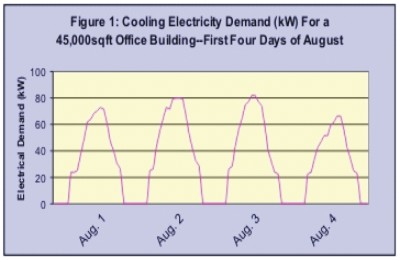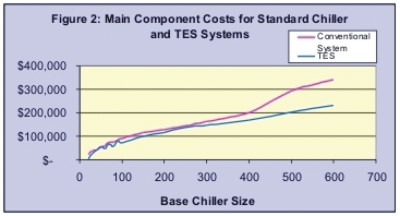
Isn’t There Already Enough Ice in the North?
Why think about making more ice on one of the first days of spring? Because thermal energy storage (TES) can help you keep your cool when summer energy bills arrive-even in the north. Thermal energy storage can also contribute to energy grid security and help your project qualify for LEED® certification.
Here’s how it works: A chiller circulates an antifreeze solution to freeze ice at night, when electricity is cheaper. The ice is typically stored in polyethylene containers that resemble large trashcans. Later, when cooling loads approach their daytime peaks as shown in Figure 1, the ice is melted to cool the building. To be cost effective, the chiller is still used during the day, but at a significantly lower loading.


Utilities benefit by their customer’s off-peak chiller use, avoiding costly investments in additional peaking generation equipment that would otherwise remain idle for significant portions of the year. Utilities encourage strategies to shift electricity use off peak (like TES) by charging more for energy (kWh) during peak hours (time-of-day rates) and by charging additional demand (kW) fees based on the highest demand recorded by the customer during the month. The strategy of TES is to reduce demand charges by shaving off the peaks and filling in the valleys in Figure 1 by making ice at night.
What are the Costs?
Because ice storage containers are generally less expensive than chillers, the first cost of a carefully sized ice storage system can be less than a standard chiller system. Figure 2 compares costs of a conventional chiller and tower with costs for corresponding TES components (a chiller and tower half as large with ice-storage equipment) using Means Mechanical Cost Data.
To get an idea of the potential savings involved, consider a 45,000 square foot office building with 73,000 ton-hours of annual cooling. This building’s energy use was modeled with DOE-2 using current-code level lighting and shell, 19% glazing with average properties, variable volume air handling systems, and an 80-ton chiller and tower delivered cooling at 1 kW/ton., The model assumes that no cooling occurs when the building is unoccupied, and an energy cost of $0.05/kWh.
A corresponding TES system, consisting of a 40-ton chiller and tower making 400 ton-hours of ice at an efficiency of 1.2 kW/ton, could reduce peak demand by 20kW for about five months of the year. The annual savings would be more than $1100-even after absorbing about $70 of additional energy (kWh) costs due to the kW/ton penalty. This result is based on inspection of the DOE-2 model and assumes a peak demand charge of $12/kW and an off-peak energy rate of $0.04/kWh.
In this example, the TES chiller is half the size of the conventional system’s chiller. The aim is to have the chiller run at near full load 24 hours per day on the design day to maximize use of capital. Even when not operating during design conditions, recharging ice completely and depleting it completely during on-peak hours makes maximal use of TES equipment. This strategy will typically result in lower energy and demand charges in spite of the TES chiller’s kW/ton penalty. For a TES system with no added first cost relative to a conventional system, these savings translate into monthly income for the life of the system.
Conclusions
A TES system isn’t really an energy conservation measure; it’s an energy cost reduction measure and a resource reduction measure when considering avoided utility infrastructure and its embedded energy requirements. The benefits to the utility (and your pocketbook) can be substantial-even in the north. LEED® NC projects subject to peak energy and demand charges have more reason to consider TES, because earning some of the ten points for Energy and Atmosphere credit 1 (Optimize Energy Performance) depends on energy cost savings, not merely overall energy savings.




